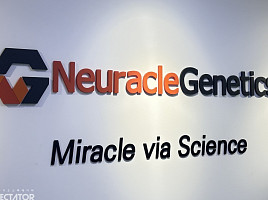기사본문
BnH Research's AD Treatment Strategy for cerebral cortical 'Nervous Plasticity↑'
입력 2024-01-22 15:22 수정 2024-01-24 10:34
by Yoonseok Suh

BnH Research develops an Alzheimer's disease(AD) treatment with a mechanism that improves cognitive ability by strengthening the neuroplasticity of the adult cerebral cortex.
Neuroplasticity refers to the ability of brain cells' neuron-neuron connections(synapses) to engage in cognitive function, learning, and memory as they change in response to external stimuli. New information is easily learned in childhood with high neuroplasticity, but after such a critical period, it is known that the neuroplasticity decreases and does not respond well to external stimuli. This means that learning takes more time and efficiency decreases.
“We are currently developing a benign allosteric modulator(PAM) candidate substance, `BnH101,' which targets GluN2B, which is known to be the core of enhancing neuroplasticity in the cerebral cortex,'' said Jeong Seung-soo, CEO of BnH Research. “We plan to submit a phase 1/2a clinical trial plan (IND) for Alzheimer’s disease(AD) earlier this year."
BnH was established by Jeong Seung-soo, a professor at Yonsei University University, in 2016, and currently has about 15 master's and doctoral researchers. BNH attracted 5.5 billion won for Series A in 2020 and 12 billion won for Series B in 2022, and is currently attracting investment from Series C.
BnH expects that BnH101, which is being developed as an oral drug, will have safety advantages as well as differentiated mechanisms to restore neuroplasticity. It is pointed out that the recently approved treatment for amyloid-beta(Aβ) targets removes Aβ in the brain, but only delays deterioration rather than recovery of cognitive ability. This is because it has no neuroplastic enhancement effect. In addition, Aβ antibody treatment has limitations in that it has side effects of ARIA such as cerebral edema(ARIA-E) and cerebral microbleeding(ARIA-H).
BnH confirmed an increase in the expression of the neuroplastic markers GluN2B and BDNF proteins in cell models treated with BnH101 and AD mouse models(APP/PS1). In addition, the AD mouse model administered BnH101 showed increased cognitive ability along with enhanced neuroplasticity, and reduced amyloidβ(Aβ) plaques and neuroinflammation.
BnH is working on the development of treatments for various diseases that can strengthen cognitive function through neuroplasticity enhancement. BnH is currently researching and developing BnH102, a candidate for post-traumatic stress disorder(PTSD), and BnH201, a candidate for vascular dementia, in addition to BnH101, a candidate for Alzheimer's disease treatment.
‘BnH101’, showing ↑"Synaptic plasticity and cognitive ability" from AD mouse model
Alzheimer's disease is one of the most degenerative brain diseases that occurs in the elderly population aged 65 or older. The formation of abnormal proteins due to the accumulation of amyloidβ(Aβ) or tau protein in the brain is known to be the main cause of Alzheimer's disease.
The currently approved antibody treatments ’Aduhelm, aducanumab’ and ‘Leqembi, lecanemab’ fail to restore cognitive ability and only delay regression despite removing Aβ protein in the brain, and have a high risk of ARIA side effects such as brain edema and cerebral hemorrhage. In addition, ‘Aricept, donepezil,’ ‘Exelon, rivastigmine,’ ‘Reminyl, galantamine’ and ‘Namenda,’ which are currently used as AD treatments, only delay cognitive deterioration.
BnH confirmed that BnH101 significantly increased the protein expression of GluN2B and the level of brain derived neurotrophic factor(BDNF) compared to the placebo group in an in vitro study using a neuronal model. GluN2B is a marker for strengthening synaptic plasticity and activating memory cells and BDNF is a marker related to nerve growth, and both are used as a marker for activating neuroplasticity.
In particular, BnH confirmed its potential as a result of treating cell models with the GluN2A inhibitors, TCN201 and BnH101. It also confirmed the increase in the expression of gluN2B protein in cell models treated with cyclotraxin B(cyclotraxin B), a BDNF inhibitor. This means that BnH101 acts selectively with GluN2B and strengthens neuroplasticity through the BDNF signaling pathway.
In a 15-month-old AD mouse model(APP/PS1 mouse) administered 1 mg/kg of BnH101, GluN2B and BDNF expression in the hippocampus and cerebral cortex regions of the brain significantly increased compared to the placebo group (p<0.05). In addition, a neurophysiological analysis was conducted on the hippocampus of the AD mouse model brain, and the results showed that BnH101 significantly improved neuroplasticity by simultaneously activating neurons in the cerebral cortex and hippocampus. This neuroplasticity enhancing effect tended to increase in a dose-dependent manner as BnH101 was administered in increasing amounts from 0.1 to 10 mg/kg.
In particular, CEO Jeong explained, "LTP(longterm potential) increased by 30-40% compared to placebo in the hippocampus of the AD mouse model administered BnH101, and this level of increase in LTP is strengthened enough to show a learning effect."
BnH confirmed the effect of improving cognitive memory of the 15-month-old AD mouse model administered with BnH101. Specifically, BnH confirmed that the response frequency of the BnH101 administration group and the placebo group was significantly improved to 15.00±2.87 and 6.571±0.157, respectively, in the active avoidance test conducted 8 days after drug administration (p<0.05). The active avoidance test applies electrical stimulation to the sole of a mouse and analyzes the response to avoid it, and when the cognitive ability is poor, avoidance reaction is not good.

‘BnH101’, showing ↓ in “Aβ plaques and neuroinflammation in microglial cells” from AD mouse model
BnH101 confirmed the reduction of immuno-inflammatory response markers through the removal of Aβ plaques and microglia activation in vitro and in vivo models, along with the effects of improving cognitive ability. Specifically, after one month of administration of BnH101 to the AD mouse model, the analysis of brain tissue significantly reduced Aβ plaques(p<0.001), and significantly reduced expression of Iba1, a microglia marker, and Osteopontin, a neuroinflammatory marker(OPN)(p<0.05).
In addition, BnH confirmed that mRNA expression of IL-33 was significantly increased in sensory neurons(S1) of AD mouse models administered BnH101, while mRNA expression of OPN was significantly decreased(p<0.05). IL-33 is known to enhance neuroplasticity and promote Aβ plaque clearance through synaptic formation, and OPN is known to cause neuroinflammatory and to be involved in Aβ plaque accumulation.
BnH confirmed that astrocyte and Aβ plaques were significantly reduced in the cerebral cortex of the AD mouse model administered BnH101(p<0.01). In addition, BnH101 showed a significant reduction in abnormal nerve fiber protein and plaque protein in the cerebral cortex tissue of the AD mouse model compared to the placebo group(p<0.05).
CEO Jeong said, "BnH101 improves neuroplasticity of the cerebral cortex through the GluN2B-BDNF signaling pathway and regulates the expression of IL-33 and OPN to treat AD by reducing Aβ plaques and neuroinflammation in microglia and astrocytes." "We plan to conduct clinical trials by confirming safety in phase 1 clinical trials that are conducted for four weeks, and adding some patients in subsequent clinical trials."
In fact, looking at AD-related studies of IL-33 and OPN, whose expression is regulated by BnH101, IL-33 overexpression in AD mouse models(APP/PS1 mice) activated macrophage of microglia by regulating gene expression in microglia. This in turn reduced Aβ plaques accumulated in brain tissue (doi.org/10.1016/j.celrep.2020.107530). In addition, AD mouse models(APP/PS1) administered IL-33 had increased cognitive function as neuroplasticity was enhanced in the hippocampal region of the brain, and regulated the expression of biomarkers involved in inflammatory responses (doi.org/10.1073/pnas.1604032113).
Osteopontin(OPN), which is produced in microglia, is known to be related to neurological diseases including AD while causing inflammation(doi.org/10.1073/pnas.2218915120). In particular, OPN was produced only in CD11c-positive microglial cells, and in the brain of a 9-month-old AD mouse model(5XFAD), OPN expression increased more than 4-fold compared to the wild type(WT). In the OPN knock-out(KO) AD mouse model, Aβ plaque accumulation significantly decreased with aging from 6 and 9 months model, and the cognitive abilities analyzed through the water-maze T test were significantly improved compared to the AD model(p<0.01).
The research team confirmed that CD11c-positive microglia and OPN expression were significantly increased in the brain tissue of AD patients compared to normal people, and showed a significant correlation between OPN expression and AD severity(p=0.0032). This means that the higher the OPN expression, the more severe the AD symptoms are. The research team confirmed that the administration of OPN antibodies to the AD mouse model resulted in a decrease in the inflammatory response in brain tissue and a decrease in Aβ plaque accumulation (doi.org/10.1073/pnas.2218915120).

관련기사
- In the Grey Area of PD-1, Tecentriq Demonstrates Improved PFS in EGFR Mutatio...
- Lunit's Efforts to Transform AI Breast Cancer Screening Featured in The Lance...
- ABL Bio has entered the PD-L1x4-1BB BsAb competition with promising Phase 1 i...
- Orion Acquires Leading ADC Player LegoChemBio for KRW 550B
- ImmunAbs, developing a novel C5 antibody for complement-associated autoimmunity







